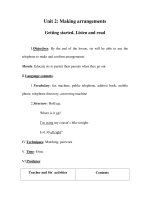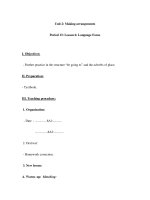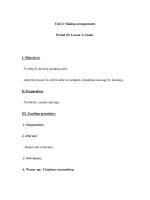Unit 2. Making arrangements
Bạn đang xem bản rút gọn của tài liệu. Xem và tải ngay bản đầy đủ của tài liệu tại đây (163.21 KB, 13 trang )
<span class='text_page_counter'>(1)</span><div class='page_container' data-page=1>
<b>UNIT 2: MAKING ARRANGEMENTS</b>
<i><b>Division of lessons:</b></i>
1. Getting started and Listen & read
2. Speak + Listen
3. Read
4. Write
5. Language focus
Week: 3
Date: 27/08/2012
<b>Period: 07 </b>
<b> </b>
<b> </b>
<b> </b>
<b> UNIT 2: LESSON 1 GETTING STARTED </b>
<b>LISTEN AND READ</b>
<b> I. Aims: By the end of the lesson, Ss will be able to use the telephone to make and confirm </b>
arrangements
<b>II. Language contents</b>
1/ Grammar: Future with “be going to”
2/Vocabulary: arrange, herself
<b> III. Techniques: </b>
Matching, Open- prediction, Role-play, Guessing game
<b>IV Teaching aids:</b>
Textbook, poster, pictures
<b>V. Procedures:</b>
Teacher’s & Students’ activities
Contents
T asks Ss to look at 6 pictures and asks
some questions
SS work in pairs, matching each objects
(pictures on page 18) with its names
T calls some answers to give marks
T calls some pairs to check the answers
T gives the definitions of these objects on a
poster and asks Ss to match the objects with
its definition
Ss work individually
T sets the scene <i>“ Hoa and Nga talking on </i>
<i>the phone. They are talking about going to </i>
<b>1.Warm up:</b>
<b>Marks(10)</b>
<b>*Getting started </b>
What is this?
When do you use it?
<i>*Keys:</i>
a. an answering machine
b. a mobile phone
c. a fax machine
d. a telephone directory
e. a public telephone
f. an address book
<i>Definition</i>
1. to send fax
2. to find someone’s telephone number
3. to write addresses and telephone number
4. to make a phone call in a street telephone
5. to leave and take message
6. to make phone call anywhere you like
<i><b>Keys: </b></i>
</div>
<span class='text_page_counter'>(2)</span><div class='page_container' data-page=2>
<i>see a movie”</i>
T ask SS to guess who did those thing
Ss guess s
T
T asks Ss to listen to the tape(twice)
Ss check their guessing
T has Sts to open their book
T reads the dial .then has Sts practice the
dial in pair.
T Has Sts to practice in pair the questions
T corrects the mistakes
T asks some questions, corrects and gives
marks to Sts
T Gives a situation. Then has Sts to play in
roles
Ss play roles of two Ss who are talking on
the phone making arrangements
Ss change the information
<b>2.Presentation: </b>
<b>New words:</b>
Arrange (v) sắp sếp, sắp đặt
Herself: chính cơ ấy
Introduce (v) giới thiệu
Downstairs (v) đi xuống cầu thang
<b>Model sentence</b>
Be going to: diễn tả tương lai gần, diễn tả dự định
mà người nói đã quyết định làm trong 1 thời điểm
đã xác định ở tương lai
Ex: We are going to have a holiday next week
<i><b>Guessing:</b></i>
Who Guess Keys
a. made the phone?
b. introduced
herself?
c. invited the other
to movies?
d. arranged a
meeting place?
e .arranged the time?
f. agreed to the
time?
Nga
Nga
Nga
Nga
Hoa
Nga
<b>3.Practice:</b>
<b>1/</b>
-the dial /19
<b>2/</b>
a. Nga made the call
b. Nga introduced herself
c. Nga invited the other to movies
d. Nga arranged a meeting place
e. Hoa arranged the time
f. Nga agreed to the time
<b>4 .Production</b>
<i>Questions</i>
a/ What is Hoa’s telephone number?
b/ Which movie are they going to see?
c/ How is Hoa going to the movies?
d/ Where are they going to meet? What time?
Lan and Lien are making arrangements
to go to the movie. They are going to see a cartoon.
It’s “Snow White and the Seven Dwarfs”
5.Homework:
- Learn new words and structure
- Practice the dial again
- Get the content of the dial
</div>
<span class='text_page_counter'>(3)</span><div class='page_container' data-page=3>
+ do exercise 1, 2 before at home
+ listen the tape in at home and get fill the missing
information
<i><b>Comments:</b></i>
<i><b>Attendance: Class 8A 1: </b></i>
<i><b> Class 8A 2:</b></i>
-Ưu điểm:
+Nội
dung:---+ Phương
pháp:---+ Đddh
:---Khuyết điểm:
+ Nội
dung:---+ Phương
pháp:---+ Đddh:
-Hướng khắc phục:
+ Nội
dung:---+ Phương
pháp:---+ Đddh:
:---Week 3
Date: 30/08/2012
Period: 08
<b>UNIT 2: LESSON 2 SPEAK -LISTEN</b>
<b> I. Aim: </b>
By the end of the lesson, Sts will be able to talk about intentions on next holidays, making
arrangements on the phone, write message on the phone.
<b>II. Language contents</b>
a/ <i>Grammar</i> : S + be+ going to+ Infinitive (to talk about intentions and activities in the future)
Adverb of place
b/ <i>Vocabulary</i> : message(n) -principal(n) -appointment
<b> III. Techniques: </b>
</div>
<span class='text_page_counter'>(4)</span><div class='page_container' data-page=4>
<b> IV. Teaching aids: </b>
Textbook, cassettes
<b> V. Procedures:</b>
<b>Teacher’s and students’ activities</b> <b>Content</b>
- T asks Ss to play the game: Divide students into
2 teams.
Rules: “E<i>ach team takes turns to choose any</i>
<i>number. You have to look at the pictures to guess</i>
<i>what they are. If you have the correct answer,</i>
<i>you will get 1 point. If any team can give me the</i>
<i>red word before all the crosswords are found,</i>
<i>that team will get 3 points.”</i>
- T checks instructions
Cues:
1. antonym of ‘fat’
2. Dream City, Titanic, ...
3. (picture)
4. (picture) what are they playing?
5. a child whose parents died
6. antonym of ‘long’
7. synonym of ‘fair’
8. (Gap-filling): Lam is not old ... to drive
a car.
9. antonym of ‘sociable’
- Students play the games in team.
- After the key word “telephone” is revealed, T
asks students the following questions:
+ Do you have a telephone at home?
+ How often do you make a phone call?
+ What would you say when you pick up the
phone to answer it?
+ What would you say when you are the caller?
- Students listen to teacher’s questions and
answer.
- T elicits the vocabulary and models three times.
- T asks Ss some questions to check Ss'
understanding and focus on the structure GOING
TO.
1. Are they talking on the phone?
2. What do they intend to do?
3. What time are they meeting? Where?
4. What form of verbs do you use to talk about
intentions?
- Ss’ expected answers:
1. Yes
<b>I. WARM UP</b>
Crossword
1 <b>T</b> <b>H</b> <b>I</b> <b>N</b>
2 <b>M</b> <b>O</b> <b>V</b> <b>I</b> <b>E</b>
3 <b>C</b> <b>U</b> <b>R</b> <b>L</b> <b>Y</b>
4 <b>C</b> <b>H</b> <b>E</b> <b>S</b> <b>S</b>
5 <b>O</b> <b>R</b> <b>P</b> <b>H</b> <b>A</b> <b>N</b>
6 <b>S</b> <b>H</b> <b>O</b> <b>R</b> <b>T</b>
7 <b>B</b> <b>L</b> <b>O</b> <b>N</b> <b>D</b>
8 <b>E</b> <b>N</b> <b>O</b> <b>U</b> <b>G</b> <b>H</b>
9 <b>R</b> <b>E</b> <b>S</b> <b>E</b> <b>R</b> <b>V</b> <b>E</b> <b>D</b>
<b>II. PRE- SPEAKING </b>
<i><b>1. Vocabulary:</b></i>
- a concert (picture) buổi hòa nhạc
- a band (picture) ban nhacr5
- junior high school (n) THCS
- principal(n) hiệu trưởng
- appointment (n) sắp xếp để gặp ai
<b>2. Model sentence</b>
<b>Near Future Tense</b>
<i><b>Form:</b></i>
</div>
<span class='text_page_counter'>(5)</span><div class='page_container' data-page=5>
2. They intend to go to the pop concert
3. They are meeting inside the center at 7.15.
4. be going to
- T asks Ss to do exercise 1 on P. 20. Ss have to
work in pairs to put the sentences in the correct
order to make a complete conversation.
- Set the scene: “Ba and Bao are making
arrangements to play chess."
- Ask Ss to work with their partners to complete
the dialogue.
- Ss work in pairs to complete the dialogue
- Students play the role of Ba and Bao. They can
change some information like the model
dialogue.
- T asks Ss to look at the form of the telephone
message on P. 21 and sets the scene: "<i>a woman</i>
<i>phoned the principal of Kingston junior high</i>
<i>school, but he was out</i>"
- T has Ss guess the message
- T gets Ss to listen to the tape twice and fill in
the message, compare with their guess.
- T gives feedback
<b>III. WHILE – SPEAKING </b>
<i><b>1. Ordering:</b></i>
- Expected answers:
1 b, 2 f, 3 j, 4 a, 5 i, 6 c, 7 e, 8 k, 9
-g, 10 - h, 11 - d.
<i><b>2. Dialogue completion:</b></i>
Expected answer:
- Can/May I speak to Ba, please? This is Bao
- I’m fine, thanks. How about you?
- Can you play chess tonight?
- How about tomorrow afternoon?
- I’ll meet you at the Central Chess Club
- Is 2.00 OK?
<i><b>IV. POST - SPEAKING</b></i>
<i><b>Model dialogue:</b></i>
Lan: Hello, 3825022
Mai: Can I speak to Lan, please? This is Mai
Lan: Hello, Mai. How are you?
Mai: I’m fine. I am going to a comedy tonight.
Would you like to come?
Lan: I’d love to, but I’m afraid I can’t. I’m
going to help my mom with the housework.
Mai: How about tomorrow evening?
Lan: Yes. I’m free tomorrow evening.
Mai: Well, I’ll meet you at Megastar theater.
Lan: At Megastar theater? Let’s meet outside
the theater.
Mai: Is 7.00 OK?
Lan: Great. See you then.
<b>PRE- LISTENING</b>
<i>Prediction</i>
Kingston junior high school
Date: ...
Time: ...
For: ...
Message: ...
Telephone: ...
<b>WHILE- LISTENING</b>
- Expected answers:
Kingston junior high school
Date: Tuesday
Time: 9.45
For: the principal
</div>
<span class='text_page_counter'>(6)</span><div class='page_container' data-page=6>
Has Sts summary the content of the message
T corrects if they wrong
T can give marks to encourage Sts
Telephone number: 6468370942
<b>POST LISTENING</b>
<b>V. Homework:</b>
- Learn by heart new words
- Practice the dial
- Prepare Unit 2 Read
+ find the words
+ meaning of the words
+ the content of the text
+ say the statements true or false
+ put events in to order
<i><b>Comments:</b></i>
<i><b>Attendance: Class 8A 1: </b></i>
<i><b> Class 8A 2:</b></i>
-Ưu điểm:
+Nội
dung:---+ Phương
pháp:---+ Đddh
:---Khuyết điểm:
+ Nội
dung:---+ Phương
pháp:---+ Đddh:
-Hướng khắc phục:
+ Nội
dung:---+ Phương
pháp:---+ Đddh:
:---Week: 03
Date: 30/8/2012
Period: 09
<b>UNIT 2: LESSON 3 READ</b>
<b>I. Aims: </b>
<b> By the end of the lesson, students will be able to know more about Alexander Graham Bell and</b>
practice reading skill for specific information.
<b>II. Language contents:</b>
a/ <i>Grammar</i> : Simple past
b/ <i>Vocabulary</i> : (v) emigrate, transmit, conduct, demonstrate
(n) a device, a deaf-mute, assistant, device ,exhibition
<b>III. Techniques: </b>
What & Where, T/F statements prediction, Ordering
<b>IV. Teaching aids: </b>
</div>
<span class='text_page_counter'>(7)</span><div class='page_container' data-page=7>
Teacher and Students’ activities
Contents
T lets Ss answer the questions by coming to
the board and write
Ss write the answer on the board.
T corrects and can give possible answers
then give marks to Sts
- T elicits: “The telephone has a number of
functions, but do you know who invented
it?”
+ Ss: “Yes, A. Graham Bell.”
- T: “Right. Today we are going to learn
something about Bell and his great
invention: the telephone”
T introduces some new words
Ss listen and guess the meaning
T explains the words by using simple
English
T has Ss repeat the words in chorus
T checks Sts memory
T give the poster of T/F statements on the
board
Ss work in pairs
Ss guess which statements are true or false
T asks Ss to read the text on page 21,22 and
check their prediction
T has Ss correct false statements
Ss write the true statements on the board
T gets Ss to read the events of Bell’s life
and put them in the correct order.
Ss compare with their partners
T gives the key
1.Warm up :Marks(10 marks)
<i>*Brainstorming</i>
What is the telephone used for?
.to chat with friend
.to have a message
.to talk to a person who lives far from
.to call someone
.to make arrangements
.to get information at the airport
<b>2/ Pre- reading</b>
Pre-teach vocabulary
emigrate(v): go to another country to live
transmit(v) truyền đạt
conduct(v)=carry out
demonstrate(v)->demonstration(n)
a device(n) thiết bị, dụng cụ
a deaf –mute: a person who is unable to hear
and speak
<i>What & Where</i>
<i>T/F statements prediction</i>
a/Alexander G. Bell was born in the USA
b/He works with deaf-mute patients in a
hospital in Boston
c/Thomas Watson was Bell’s assistant
d/ Bell and Watson introduced the telephone in
1877.
e/Bell experimented with ways of transmit
speech between deaf-mutes over a long
distance
f/ Bell demonstrated his invention at a lot of
exhibitions.
<b>3/While-reading</b>
1/ <i>Keys</i>:
1. He was born in Edinburgh in Scotland.
2. He worked with deaf-mute patients at Boston
University.
3. T
4. He introduced telephone in 1876
5. He experimented with ways of transmitting
speech over a long distance.
6. T
2/<sub></sub> Ordering
</div>
<span class='text_page_counter'>(8)</span><div class='page_container' data-page=8>
- T sticks poster of “Gap-filling” on board
and asks students to work in pairs.
- Ss answer, and then T gives feedback
3. went to live in the United States.
4. worked with people who could neither speak
nor hear.
5. worked with Thomas Watson
6. successfully demonstrated his invention.
7. invented the telephone.
<b>4/Post –reading</b>
1. A. G. Bell was born in ... on March
3, ...
2. Bell ... to the USA in the 1987s and
worked at a ... in Boston.
3. He invented the ... after ... with
ways of transmitting speech over a long
distance.
4. In ..., Bell and Watson introduced a
device.
5. The first telephone message was:
“...”
6. The first telephone was used commercially
in ...
Expected answers:
1. Edinburgh / 1847
2. emigrated / university
3. telephone / experimenting
4. 1876
5. Mr. Watson, come here. I want you
6. 1877
<b>5/Homework</b>
-Learn the new words by heart
-Do exercise 5 in workbook
-Prepare Unit 2 lesson 4 Write
+find the word
+read the text
+write the message
<i><b>Comments:</b></i>
<i><b>Attendance: Class 8A 1: </b></i>
<i><b> Class 8A 2:</b></i>
-Ưu điểm:
+Nội
dung:---+ Phương
pháp:---+ Đddh
:---Khuyết điểm:
+ Nội
dung:---+ Phương
pháp:---+ Đddh:
-Hướng khắc phục:
</div>
<span class='text_page_counter'>(9)</span><div class='page_container' data-page=9>
:---Week: 04
Date: 06/9/2012
Period: 10
<b>UNIT 2: LESSON 4 WRITE</b>
<b> </b>
I. Aims:
By the end of the lesson, Ss will be able to write a telephone message
II. Language contents:
1/Grammar:
Simple Past
2/Vocabulary:
A customer, a delivery, stationary, pick someone up
<b> III. Techniques: </b>
Chatting, Rub out and remember
IV. Teaching aids:
Textbook, sub- board.
V. Procedures:
Teacher’s and student’s activities
Contents
- T writes the words whose letters are in
random order on the board.
- T divides the class into 2 teams: Ss from 2
teams go to the BB and write the correct words.
The team writing more correct words first wins
the game.
- Students play the game in team.
T asks Ss to talk to a telephone message
Ss talk to one another
T presents some words
Sts repeat (in individually and chorally) and Sts
copy
<b>1.Warm up :</b>
1. mcuestor = customer
2. ayddmi = midday
3. essgmea = message
4. nifurretu = furniture
5. rvseice = service
6. oerdr = order
<b>2..Pre- writing:</b>
<b>*vocabulary:</b>
a customer: a person who comes to buy
something at a shop
a delivery
stationary(n) ( example: paper, pens)
pick someone up
Rub out and remember
<b>answer the questions</b>
1. Who is this message for?
2. Who left this message?
3. Who took this message?
<b>3.While-writing:</b>
<b>*keys:</b>
</div>
<span class='text_page_counter'>(10)</span><div class='page_container' data-page=10>
T checks Sts words by rubout and remember
T has Sts read the message in silently and
answer the questions in groups
Sts write the answers on the board
T calls Sts to read loudly in class
T gives the keys
T asks Ss to read the message and fill in the
gaps in the passage on page 23.
T let Sts work in pairs.
Sts give the answers
T gives feedback.
T asks Sts to read passage 2 on page 23 to get
information and write the message.
Let Sts write individually then share with a
partner.
T ask Sts write the telephone message for your
friends
If Sts do well, T can give marks
3.Mr Tam did
<b>1.Answers:</b>
(1)phoned (5) name
(2)May 12 (6) delivery
(3)speak (7) Mr. Ha
(4)took (8)at
<b>2.Answers:</b>
Thanh Cong Delivery Service
Date: June 16
Time; After midday
For: Mrs. Van
Message: Mr. Nam called about his
stationary order. He wanted you to call him
at 8634082.
Taken by: Mr. Toan
<b>4. Post- writing</b>
- Suggested message:
Date: September 25
Time: 4 p.m.
For: Kevin
Message: Tom called about joining his
birthday party this evening. He will wait for
you at Celadon hotel at 7 p.m.
Taken by: David
<b>5/ Homework:</b>
-Learn new words
-Do exercise 7 in workbook
-Prepare: Unit 2 lesson 5 language focus
+Near future
+ Adverbs
<i><b> Comments:</b></i>
<i><b>Attendance: Class 8A 1: </b></i>
<i><b> Class 8A 2:</b></i>
-Ưu điểm:
+Nội
dung:---+ Phương
pháp:---+ Đddh
:---Khuyết điểm:
+ Nội
dung:---
---+ Phương
pháp:---+ Đddh:
-Hướng khắc phục:
</div>
<span class='text_page_counter'>(11)</span><div class='page_container' data-page=11>
Date: 6/9/2012
Period: 11 <b> </b>
<b>UNIT 2: LESSON 5 LANGUAGE FOCUS</b>
<b>I. Aims: </b>
This period helps Ss to review the grammar points of unit 2 and do some more exercises.
<b>II. Language contents:</b>
1/ Grammar:
1. Future with be going to
2. Adverbs of place
2/ Vocabulary: Unit 2
<b>III. Techniques:</b>
Gap – fill, Matching, Jumbled words
<b>IV. Teaching aids:</b>
Sub-boards, card
<b>V. Procedures : </b>
Teacher’s and student’s activities
Contents
- T divides students into 2 teams and states
the rules of the games: “<i>There are 9 numbers</i>
<i>and three of them are storming. You will</i>
<i>choose one number and answer one</i>
<i>question. If you choose a storming number,</i>
<i>you will be discounted 2 points and lose your</i>
<i>turn. 2 points for a correct answer and no</i>
<i>point for an incorrect answer. The other</i>
<i>group helps will get 1 point for their correct</i>
<i>answer. Which group gets more points wins</i>
<i>the game</i>”
- Students of 2 teams take part in the game
- T gives feedback and comments.
- T elicits: “What form of verb do you use to
talk about intention?”
- Ss: be going to + infinitive
- T models 3 times and gets Ss repeat
- Ss repeat after the T (chorally and
<b>1.Warm up (marks)</b>
<b>Storming numbers</b>
<b>1 2 3 4 5 6 7 8 9</b>
1. SN
2. What are you going to do tomorrow?
3. Are you going to school tomorrow?
4. What are you going to do this weekend?
5. SN
6. SN
7. Are you going to see a movie tonight?
8. What city are you going to visit this
summer?
9. What time are you going to go to bed this
evening?
<b>2. Presentation : </b>
New words:
- a fishing rod:
- an action movie: (explanation: film about war
or fighting)
- outside (adv) (picture) # inside
<b>*Be going to</b>
</div>
<span class='text_page_counter'>(12)</span><div class='page_container' data-page=12>
individually)
- Ss copy down
T ha Sts to read the sentences1 /25 .then
practice the sentences in groups to say what
the people are going to do
T corrects their mistakes
- T hangs the poster of the words with
disordered letters on the BB and tells the Ss
that they are adverbs of place.
- T asks Ss to go to the BB and write the
meaningful words
- Ss go to the BB and write the meaningful
words, one student one word.
- T sets the scene: "<i>Ba is playing hide and</i>
<i>seek with his cousin, Mr. Tuan. Use the</i>
<i>adverbs of place to complete the speech</i>
<i>bubbles</i>”
- T asks Ss to do exercise 3 on p. 26.
- T asks some Ss to read out the bubbles.
T guides Sts to do homework
>Talk about intention
<b>Adverbs of place:</b>
There, outside, inside, upstairs, here, down
-stairs.
<b>3. Practice:</b>
<b>1.</b>
<b>Keys :</b>a. They are going to go fishing
b. She ‘s going to read novel
c. She’s going to do math homework
d. He’s going to watch an action movie on TV
tonight
<b>---2. a)</b>
Ex:
What are you going to do on the weekend?
Are you going to
---? <sub>you</sub> Your partner
See a movie?
Play sports?
Meet your friends?
Help your parents?
Do your homework?
Watch TV?
<b>b.</b>
Sts do
<b>4. Production:</b>
<i><b>I. Jumbled words</b></i>
1. tdeousi 4. erhe
2. siiden 5. stupairs
3. hetre 6. wonstairds
- Expected answers:
1. outside 4. here
2. inside 5. upstairs
3. there 6. downstairs
<i><b>II. Gap-filling (p. 23)</b><b> </b></i>
- Expected answers:
a. Where is Tuan? I think he is upstairs.
b. No, he isn't here.
c. He isn't downstairs and he isn’t upstairs.
d. Perhaps he's outside
e. No, he isn’t there.
f. I'm not outside. I'm inside, Ba.
<b>5/ Homework:</b>
-Do exercises again
- Learn structure and all words
</div>
<span class='text_page_counter'>(13)</span><div class='page_container' data-page=13>
+ review the present progressives tense
+ read the dial to get the content
<i><b>Comments:</b></i>
<i><b>Attendance: Class 8A 1: </b></i>
<i><b> Class 8A 2:</b></i>
-Ưu điểm:
+Nội
dung:---+ Phương
pháp:---+ Đddh
:---Khuyết điểm:
+ Nội
dung:---+ Phương
pháp:---+ Đddh:
-Hướng khắc phục:
</div>
<!--links-->









